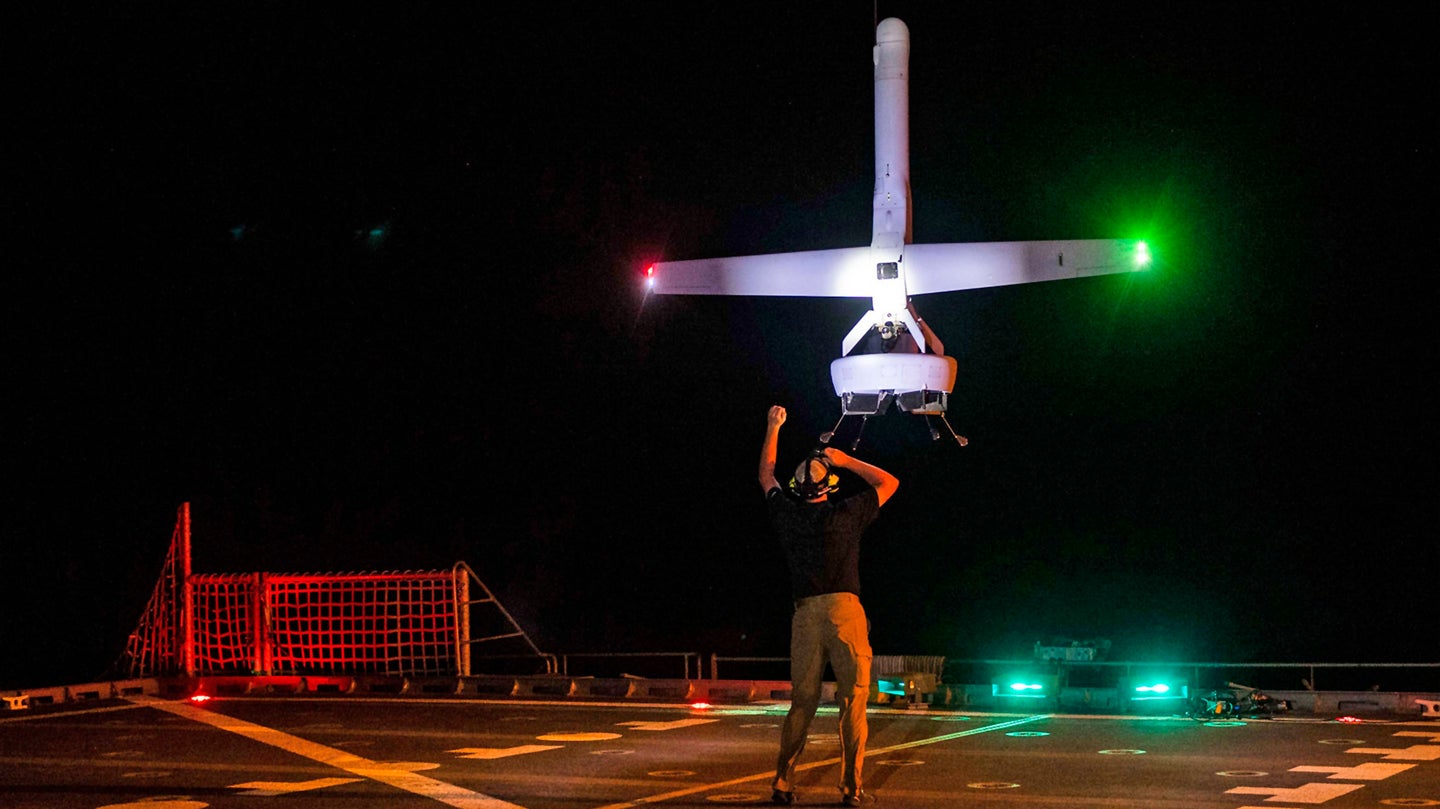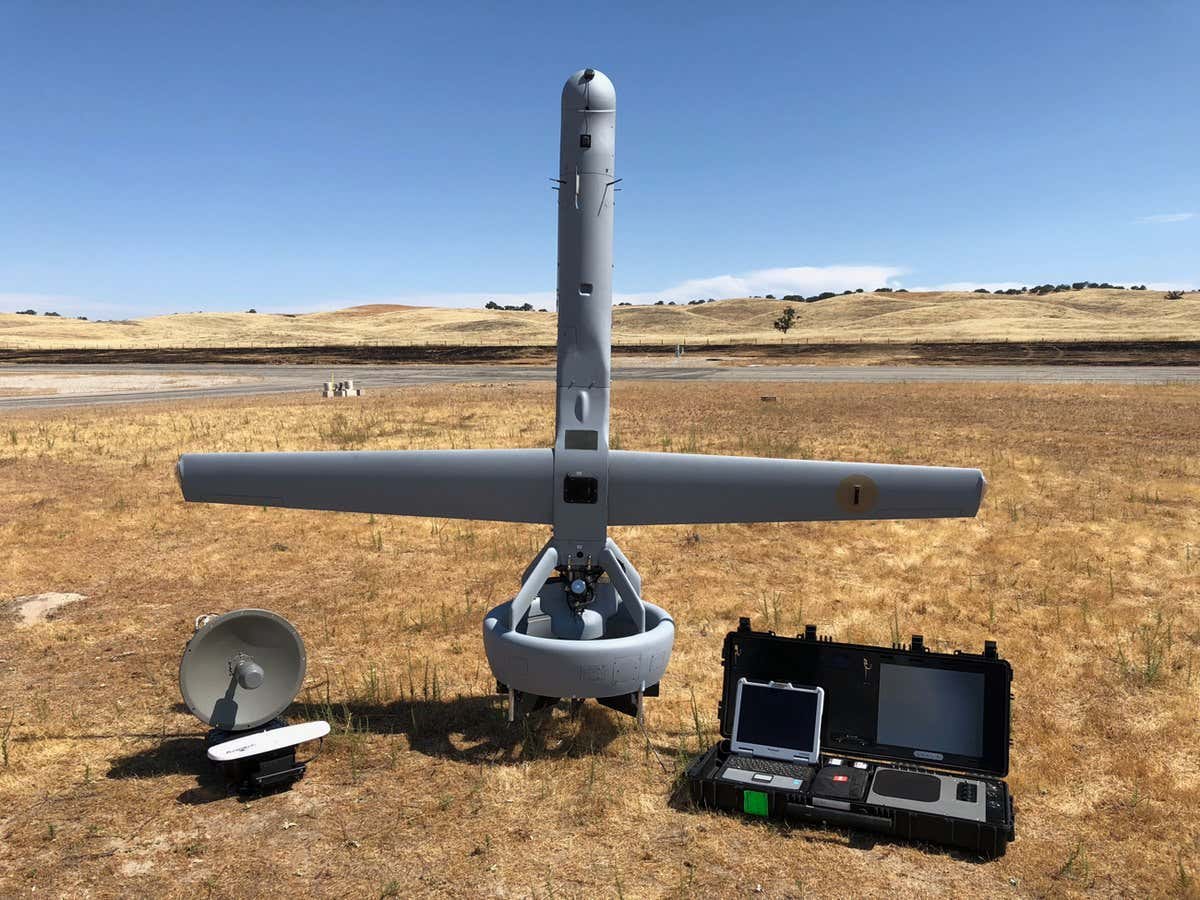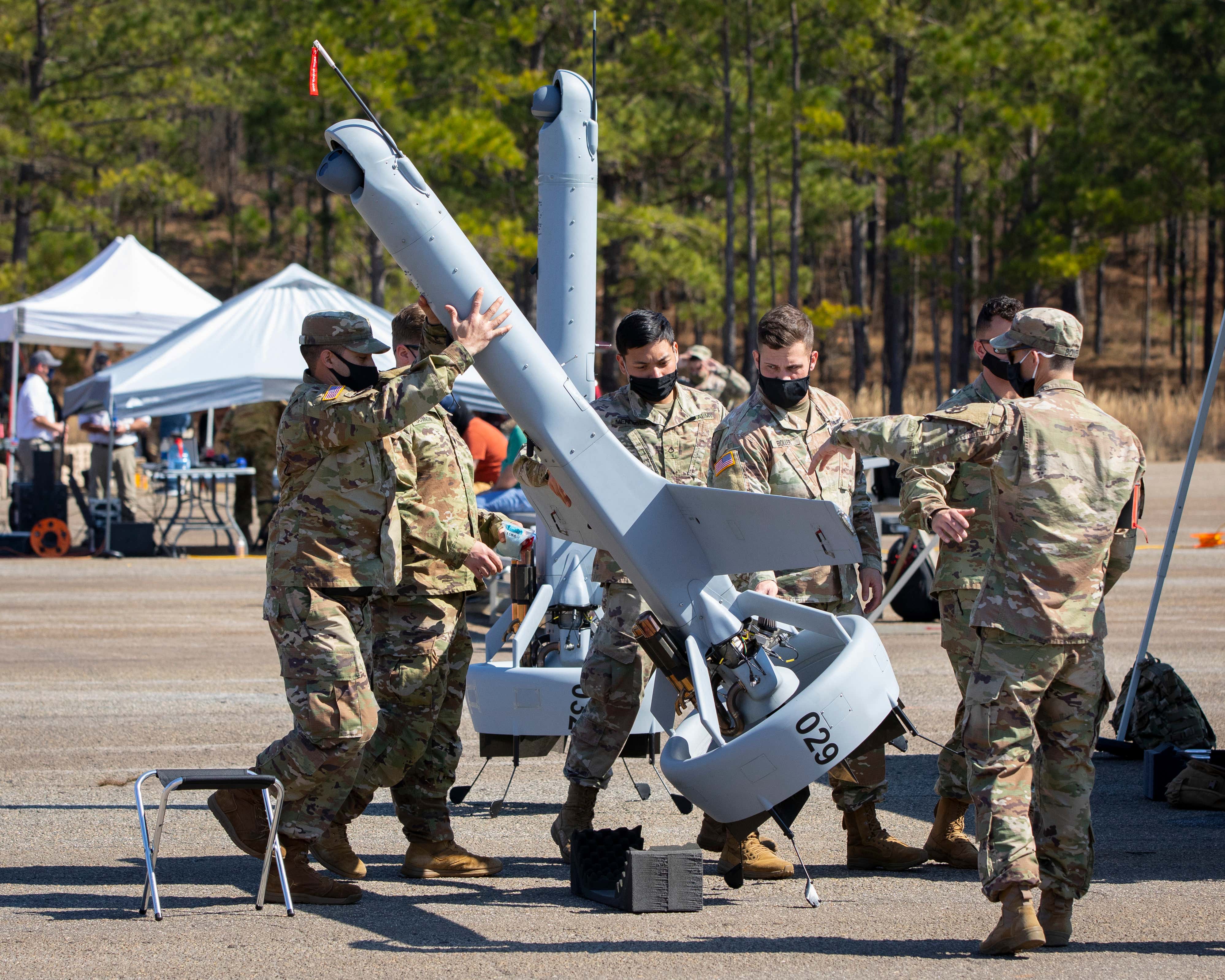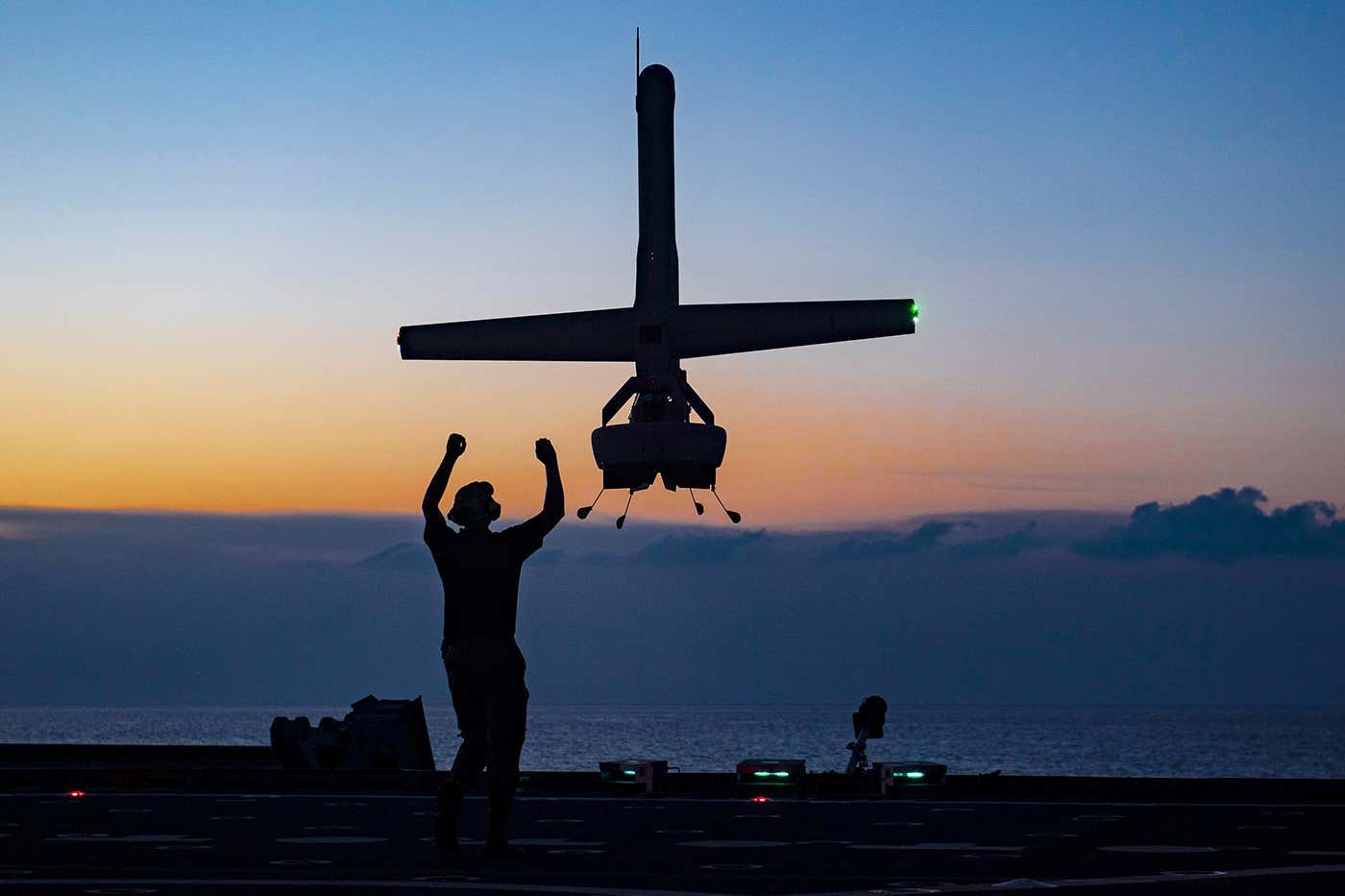
The V-Bat is getting a revolutionary AI brain, swarming capabilities, and there are plans to increase the drone's ability to work without GPS.
Artificial intelligence firm Shield AI will pair its powerful autonomy technology with the V-Bat drone, which takes off and lands vertically without the need for special infrastructure, potentially leading to a significant leap in the unmanned aircraft's capabilities, including its ability to operate as part of a swarm. The V-Bat has already been tested extensively by numerous branches of the military, and this latest news could signal that its role is set to grow as a versatile platform perfect for expeditionary missions.
The news came in a recent announcement that Shield AI had acquired the V-Bat's manufacturer, Martin UAV. Shield AI says that their proprietary Hivemind AI system is well-suited to enable unmanned aircraft to carry out a wide range of missions, and specifically lists “infantry clearance operations” and “breaching integrated air defense systems with unmanned aircraft” among them. Shield AI's autonomy systems have already been used aboard smaller quadcopter drones by U.S. Special Operations Command since 2018.

A V-Bat drone and its portable command center.
“Shield AI will integrate its combat proven autonomy software, Hivemind, into the V-BAT, reinforcing Shield AI’s leadership position in defense-focused edge autonomy,” the company’s news release reads. “The acquisition of Martin UAV complements a deliberate strategy to integrate Hivemind onto unmanned systems for defense and commercial applications.”
In the release, Brandon Tseng, Shield AI cofounder and former Navy SEAL, describes the V-Bat in three words: “Expeditionary. Intelligent. Collaborative.” Tseng says that the combination of Shield AI’s autonomy technologies and the V-Bat’s unique capabilities represents “the future of unmanned aircraft,” allowing unprecedented levels of coverage even in “high-threat environments” and enabling the drones to “make their own decisions to execute commander’s intent to accomplish missions.”
This latest press release also claims that Shield AI’s proprietary autonomy system will ”enable GPS- and communications- denied operation.” Reuben Martin, CEO of Martin UAV, elaborated on what that could mean for the battlefield of the future, noting that “GPS and communications on the battlefield are no longer assured. A great aircraft without an AI to make intelligent decisions will be sidelined against China, Russia, and an increasing number of adversaries who are fielding electronic warfare and anti-air systems.”
On Shield AI's webpage for their Hivemind AI system, the company goes further, stating simply "No GPS, No Comms, No Problem," claiming the AI system can "Remove the need for human operators, GPS, and RF [radiofrequency] links."

The Army Futures Command's Future Vertical Lift cross-functional team is
seen here conducting V-Bat flight tests in February 2021 at Leyte West
Airfield, Fort Benning, Georgia.
The V-Bat measures just nine feet in length with a wingspan of just under 10 feet and combines the low footprint required for vertical takeoff and landing (VTOL) operations with the high efficiency of a fixed-wing platform. The drone can take off or land in a nine-square-meter area independent of special infrastructure, making it perfect for crowded urban environments, expeditionary operations in austere areas, or the decks of surface ships. Being able to operate UAVs and other aircraft in GPS-denied environments is becoming a larger priority for the Pentagon, as is the ability to operate in austere or unprepared locations, both of which the VTOL drone aims to do.
The V-Bat can be transported in the bed of a pickup or inside a UH-60 Blackhawk helicopter and weighs just 125 pounds. A two-person crew can have the UAV up and running in less than a half-hour. A laptop-based user interface built into a portable hard case rounds out its impressive portability capabilities.
The drone runs on a 183cc two-stroke engine powering a ducted-fan propulsion and control system, enabling it to reach a top speed of around 90 knots and altitudes as high as 20,000 feet. Martin UAV claims the V-Bat has an 11-hour endurance and can carry payloads up to 25 lbs, making it well-suited to carry a wide variety of multi-spectral sensor systems, electronic intelligence gear, radar systems, electronic warfare suites, and communications packages. The truly modular nature of the V-Bat makes it quite useful for swarming operations, as different drones could be configured with various payloads to give an entire swarm the flexibility to carry out multiple missions and be rapidly reconfigured. It's unknown if there are any plans to arm the drone, but considering its payload capabilities, it's possible the VTOL platform could become an optionally reusable cruise missile or loitering munition in the future.
A line-of-sight datalink gives the V-Bat roughly 50-mile range, although that is largely impacted by terrain. Its range could potentially be augmented with forward-based ground control stations or through relay links to other airborne craft. When operating in a fully autonomous mode, these lines-of-sight datalinks wouldn't be as much of a factor and would allow the drones to travel even farther. Even connecting V-Bat with operators via a basic low-bandwidth satellite datalink, so it can provide simple updates for monitoring and accept simple commands, could be an option.

The V-Bat has already been used in counter-drug operations by the U.S. Navy, while the Marine Corps has been testing the VTOL drone for future use to replace aging UAV systems. The unique UAV was also recently chosen as a finalist in the Navy’s Mi2 Challenge, which seeks to “accelerate the identification and evaluation of Unmanned Aerial Systems (UAS) capable of operating in austere deployed environments without ancillary support systems.” The U.S. Army, meanwhile, is eyeing the V-Bat for future use as part of its Army Expeditionary Warrior Experiment which seeks out "concepts and capabilities at the lower tactical echelon in support of Multi-Domain Operations (MDO)." The drone is competing against three other UAVs to replace the Army's RQ-7 Shadow, which is rapidly approaching obsolescence and does not have anywhere near the capability set the V-Bat does.
Shield AI also recently acquired Heron Systems, makers of the AI systems that went undefeated in the AlphaDogfight virtual air combat trials against human pilots. It was just recently announced that the same AI “pilot” would be integrated into an L-39 Albatros jet trainer for real-world air combat testing. It's unknown if that same AI, or some version of it, will be integrated into the V-Bat in the future, but Shield AI's announcement states that the AlphaDogfight "AI pilot" system would be incorporated into various unmanned aerial systems.
Above all, the capability to launch and land swarming drones of substantial size and capability with minimal infrastructure could really be a decisive factor in future conflicts. Drones like the V-Bat that offer such a unique blend of capabilities could create a near-impenetrable intelligence, surveillance, and reconnaissance network over areas of the battlefield, enabling new levels of situational awareness and data sharing.
Brett Tingley
No comments:
Post a Comment
Note: Only a member of this blog may post a comment.